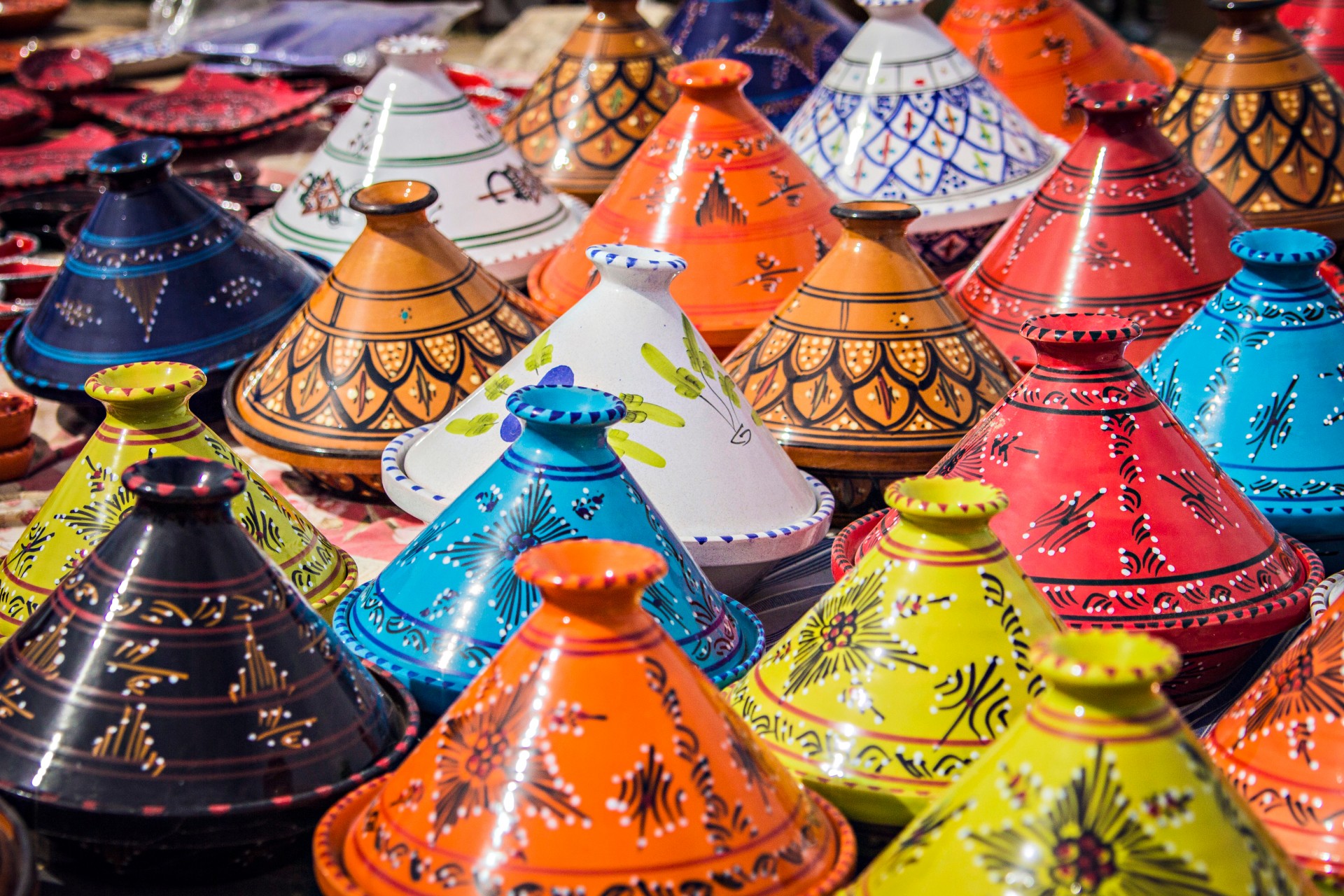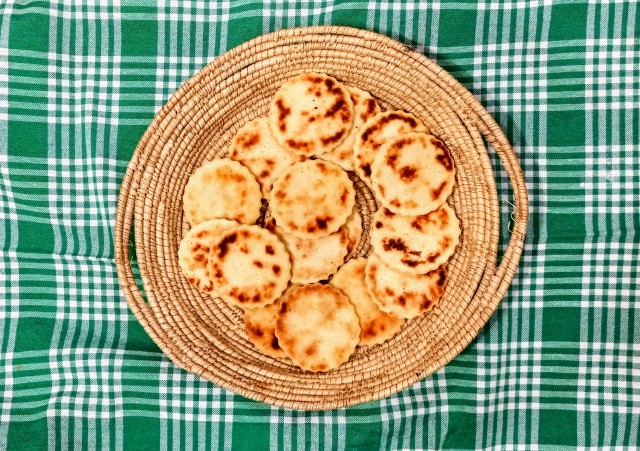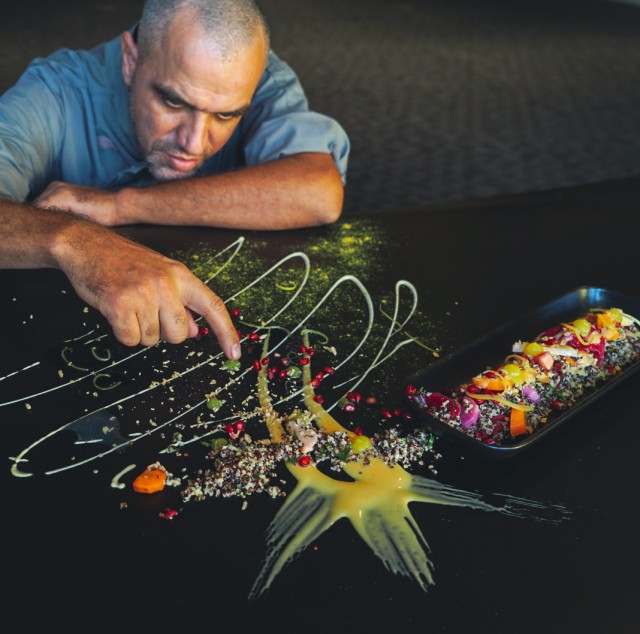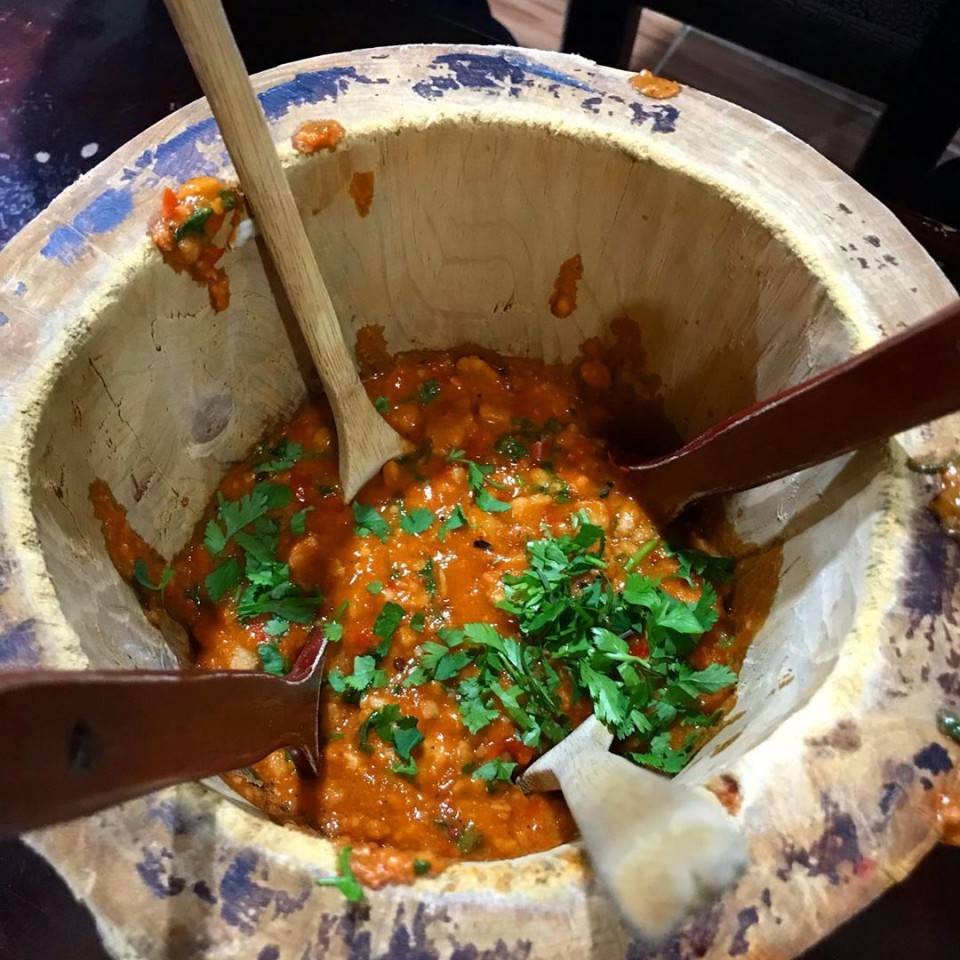Algerian cuisine with Rabah Ourrad
and his recipe for zviti

Sun_Shine / Shutterstock.com
Algeria
There was something you wanted to ask me before we start, right?
“Yes! What does Kuli-Kuli mean?”
It’s a snack popular in West-Africa! It’s made from ground, roast peanuts that are deep-fried in all shapes and sizes. Angela N'Dah-Sékou from Benin tells us all about it. Why do you ask?
“Well, that’s funny, because it’s also the feminine imperative of the word akala (to eat) in Arabic – if you want to say ‘eat eat!’ to a woman, you’d say ‘kuli kuli!’ (كُلِي كُلِي). West Africa isn’t that far away, so who knows if it’s etymologically related!” He laughs, “you’ve got the Arabic world covered with the name of your website.”
That’s brilliant! Speaking of eating… what was on the menu when you grew up?
“Like most, I grew up with my mum’s food. Couscous, lentils, beans and traditional, home-baked, semolina breads like kesra (also called galette in Algeria). Semolina is used in Algeria much like flour is used in other countries. No one in the world uses it the way we do.
“I remember our home kitchen as the centre of the house. To use the tabouna [a gas stove on the floor] you had to be flexible too – my mother would sit on one leg and stretch the other, whilst working the dough to make pasta. And she would sing while doing it too – she had such a nice voice.”
Does musical talent run in the family? You became famous rapping before you got into cooking.
“Yeah, I became the leader of the rap band MBS in 1998. We were the first Arabic rap band and got picked up abroad pretty quickly. We moved to Paris, toured the world and signed a contract with Island Records in 1999. The same label that once signed Bob Marley!
“I loved music, but I also needed to study. I studied mechanical engineering when I still lived in Algeria and couldn’t get into the engineering school I had applied to in Paris. I ended up studying French literature and finished with a degree.

“By accident, I ended up on an intensive CAP course [Certificat d'Aptitude Professionnelle is a French diploma] to become a cook. After graduating, I began working in great brasseries like le Vaudeville in Paris. Then I started cooking in Barcelona, a city that I came to love after doing a show there and later in London, where I worked in Michelin starred restaurants Sketch (with Pierre Gagnaire) and The Ledbury (with Brett Graham).”
When did you return to Algeria?
“I came back to Algeria in 2016 to be the judge of Masterchef Algeria, but it wasn't until 2018 that I moved back and settled in Algeria with my family. I agreed to join the MSuite hotel owner Meriem Bisker as partner in Mim Restaurant that then became Mim by Rabah Ourrad. I am inspired by the classic techniques of French cookery that I learned in Paris, and the flavours I have tasted elsewhere, for example I have foods such as Spanish croquettas [a breaded, deep-fried snack] with Algerian spiced roast chicken on my menu, and Britain’s fish and chips with a local twist. Anything you get in touch with becomes part of your DNA.”
Where else do you find your inspiration?
“Research, research, study, study. Sometimes new dishes come about by exploring all possibilities of ingredients. But for me, the best method is the instinctive one, when you get inspired by something around you.
“For example, we have a dish called karentika here, based on chickpeas with an omelette-like structure. It’s a classical Algerian dish – actually invented by the Spaniards in the coastal city Oran, in Fort Santa Cruz, where they had nothing but chickpea flour. You add water, salt, refrigerate. The flour sinks to the bottom and becomes compact. The top becomes fluffy after baking it.
“It’s the cheapest street food in Algeria, and popular with my staff as well. It’s easy to make. One day there was a tray leftover. I thought: we cannot throw this out. Let’s see if there’s an haute-cuisine approach to this dish…I wanted to make it gastronomical.
“I took a leftover tray, scraped off the fluffy top, whipped it into an emulsion and piped it into squares. I blowtorched the top to caramelise it (as karentika always comes browned on top), and I served it with a smoked harissa in a little pipette.”

Are there any local ingredients that inspire you?
“Well, many of the ingredients I love, like coriander and mint, can easily be found elsewhere. But something really Algerian that I love to work with is freekeh. It’s wheat that’s harvested when it’s still green and then cleaned, dried and smoked by laying it on the floor and burning the skins of the grain around it. It has a light smoky flavour and is an essential ingredient in a traditional, tomato-based meat soup called chorba frik. I use freekeh instead of rice in risotto.” He laughs, “I call it freekotto.”
I see what you did there! What makes Algerian cuisine Algerian?
“The absolute essential thing in Algerian cuisine - that I had to learn over the years - is the dosage of spices. The way they use spices in India: BAM! I love Indian cuisine, but their way of using spices can be overwhelming! Then you travel west to the Arabic countries in the Middle East and the spices are still there but not as strong as in India. On the complete opposite end of the spectrum you’d find the US and, to a lesser extent, Europe, where traditionally fewer spices are used.
“But in the centre of it all, you’ll find North Africa in general and Algeria in particular. You'll find only one or two spices in a dish but they'll be in perfect equilibrium. Use another spice in the same dish, and you'll end up with a completely different dish. We love spices, but we treat them with respect.
“And even though we might be neighbouring Morocco and have many similar dishes and preparations, there are important differences too. In Morocco, they use many sweet/sour or sweet/salty contrasts, for example by using fruit in savoury dishes. That has had its influence on the cuisine in northwestern Algeria, but that doesn’t happen in the rest of the country – we use sweetness in desserts, and in abundance too. But not in the couscous!”
Does the preparation of couscous differ much from one place to the other?
“Yeah. Different preparations of couscous almost act as dialects. Every region has its variations. Some use whole wheat, some use barley. Some add dried herbs, giving a greenish hue to the couscous. Or different salsas, different veggies or herbs.

“The most remarkable variation can be found in the Sahara: the driest place on earth, far away from the sea. The only river there is dry, but they make the only fish couscous in the country. I still need to find out how that came about. Nowadays it’s not that difficult to get a fish or two to the desert, but back in the days…
“They use interesting cooking techniques there, too. It gets so hot in these areas that they can use the sun for cooking. They bury eggs under the sand to get them cooked.”
Sounds like an amazing place to visit!
“If you don’t get to travel to the moon or Mars, at least travel to the Sahara. You may not find aliens there, but you’ll see landscapes you’ve never seen before. It’s breathtaking.
“Algeria, in general, doesn’t see as many tourists as our neighbours Morocco and Tunisia. We’ve had loads of troubles in the ‘90s (and before), and Algeria was portrayed as a country of death and terrorism, but it’s a very peaceful place now. The people here are so welcoming and very interested in getting to know others too! And if anything, come for the food – you won’t regret it.”

© Instagram: welcometomykitchen123
The Dish
What is your favourite dish from Algeria and what is the story behind it?
“Zviti! Unfortunately we Algerians were never really interested in our own culture, so we didn’t document much. Zviti was made to use up yesterday's traditional bread; the galette or kesra we spoke about earlier. They'd cut up the stale flatbread, soak it in water to rehydrate it and then use it in the zviti. It’s more common to use freshly baked bread now.
“It’s a dish that comes from M’Sila / Bousâada, south of Algiers and close to the Sahara. You won't find it elsewhere in Algeria. The traditional way of making it is in a big wooden mortar and pestle that is also used for serving the dish. That’s not something you’d have at home, so you’d have to find an alternative.
“A rolling pin and a big, plastic measuring cup could work too. But it’s important not to use a stick blender; that would destroy the texture and therefore the dish.”
Why is zviti special to you?
“I’ve only had it two or three times, but it’s my absolute favourite dish from Algeria. The different types of chilli, the garlic, the tomato, the bread. It should be piping hot. When I have it, I can’t stop eating. I start sweating. Crying. I fight the dish but I can’t stop. It’s beautiful.”
Any tips?
"You can confit the garlic by slowly roasting the cloves in olive oil before you use them, if raw garlic is too strong for you. It will give another direction to the taste that is quite delicious and different!"
The Ingredients
- Semolina flatbreads
- 200 g
- fine ground semolina
- 1 tsp
- salt
- 1 tbsp
- olive oil
- Zviti
- 4
- large tomatoes
- 2
- sweet peppers / bell peppers
- 6
- green hot peppers
- 2
- dried chillies
- 4-5
- cloves of garlic, peeled
- 1
- bunch coriander
- 1 tsp
- coarse salt
- 3-4 tbsp
- olive oil
- Semolina flatbreads
- 1.25 cups
- fine ground semolina
- 1 tsp
- salt
- 1 tbsp
- olive oil
- Zviti
- 4
- large tomatoes
- 2
- sweet peppers / bell peppers
- 6
- green hot peppers
- 2
- dried chillies
- 4-5
- cloves of garlic, peeled
- 1
- bunch coriander
- 1 tsp
- coarse salt
- 3-4 tbsp
- olive oil
The Recipe
Semolina flatbread
- Mix the semolina well with the salt, add the olive oil and add enough water to bring the dough together. It should be firm, yet malleable.
- Take pieces of the dough and flatten into 1 cm thick flatbreads.
- Heat a frying pan or other wide flat pan over a medium heat and cook the flatbreads for around 10 minutes each side.
- After cooking, cut the flatbreads into small pieces and set aside.
Zviti
- Burn the skin of green peppers, sweet peppers and tomatoes directly over an open flame until blackened. Place in a bowl, covered for a minute or two to steam then uncover to peel and remove the stems and seeds of the peppers.
- Using a large pestle and mortar or other heavy object such as a rolling pin and a bowl, crush the garlic with the salt. Add the tomato, the green and red peppers and the dried chillies, crushing as you go. Add in the flatbread pieces and continue to crush, incorporating the olive oil until it's mixed and chunky. Add a splash of hot water if it's too thick.
- Finish with the bunch of chopped coriander and serve hot in the same mortar or other serving dish.